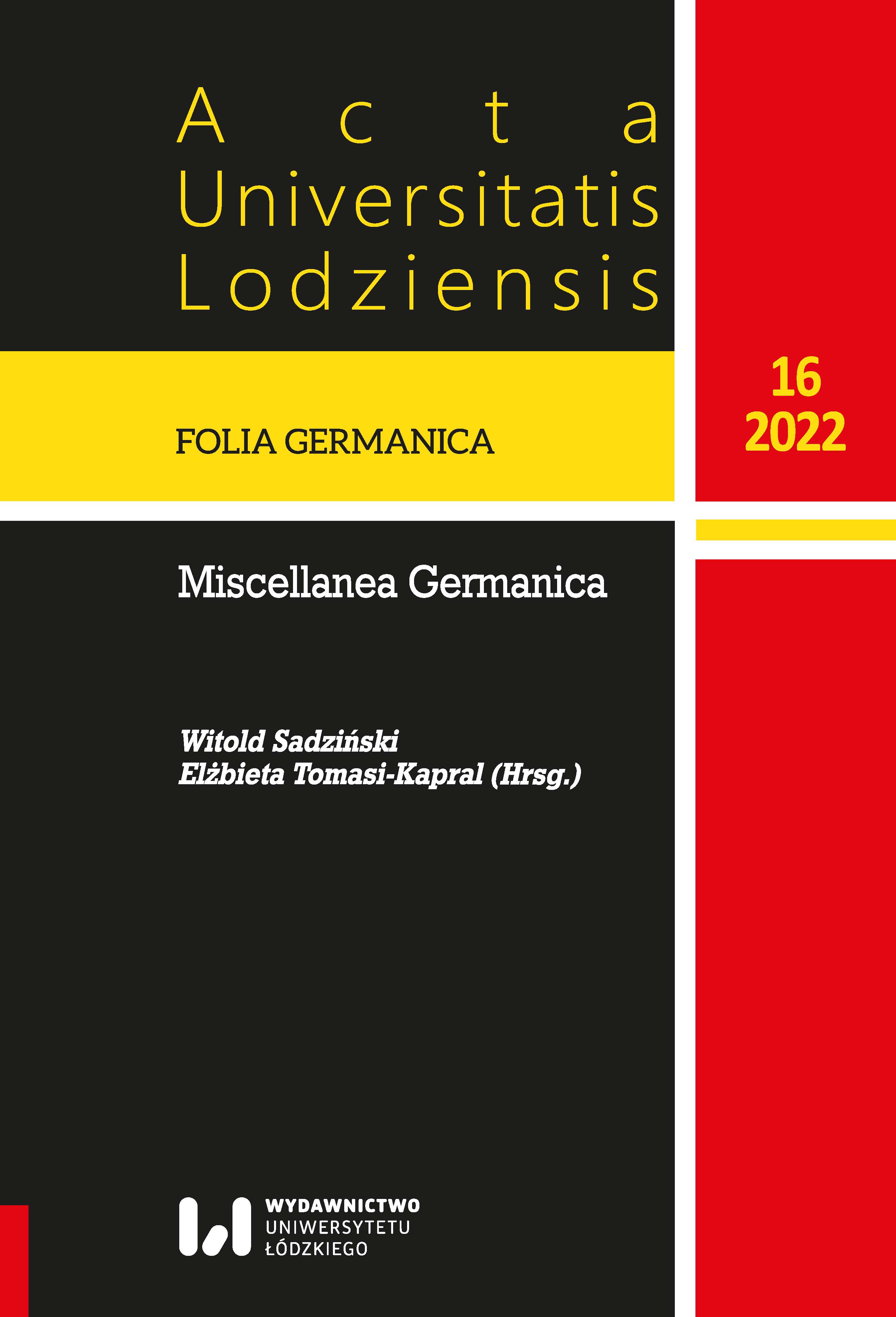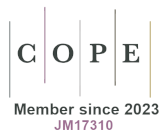Syntagma in pronunciation training – prosodic units vs. syntactic phrases
DOI:
https://doi.org/10.18778/1427-9665.16.05Keywords:
pronunciation, prosodic competence, prosodic units, phrasal stressAbstract
The article deals with the prosodic competence of learners of German, and more precisely with prosodic units. It is not always easy for learners to correctly determine these units and consequently to set correct sentence accents. Lack of correspondence between prosodic and syntactic units leads sometimes to prosodic errors. The article tries to analyze these discrepancies between prosodic units and syntactic phrases in order to determine certain regularities.
References
Abney S. (1987), The English Noun Phrase in its Sentential Aspect, Doktorarbeit. Massachusetts Institute of Technology.
Google Scholar
Ágel V. (2000), Valenztheorie. Ein Arbeitsbuch.Tübingen: Narr.
Google Scholar
Anderson-Hsieh J., Johnson R., Koehler K. (1992), The relationship between native speaker judgements of nonnative pronunciation and deviance in segmentals, prosody, and syllable structure, „Language learning“, Nr. 42, S. 529–555.
Google Scholar
DOI: https://doi.org/10.1111/j.1467-1770.1992.tb01043.x
Bech G. (1955–1957), Studien über das deutsche Verbum infinitum.1./2. Kopenhagen.
Google Scholar
Beckman M.E., Pierrehumbert J.B. (1986), Intonational structure in Japanese and English. „Phonology Yearbook“, 3, S. 255–309.
Google Scholar
DOI: https://doi.org/10.1017/S095267570000066X
Benkwitz A. (2004), Kontrastive phonetische Untersuchungen zum Rhythmus: Britisches Englisch als Ausgangssprache – Deutsch als Zielsprache. Frankfurt am Maine: Peter Lang.
Google Scholar
Bloomfield L. (1933), Language. New York.
Google Scholar
Bogdal K.-M. (2008), BA-Studium Germanistik: ein Lehrbuch. Reinbek bei Hamburg: Rowohlt.
Google Scholar
Bose I. (1995), Auf den Rhythmus kommt es an … Zur Akzentuierung und Gliederung im Deutschen.In: E. Endt, U. Hirschfeld (Hg.), Die Rhythmuslokomotive. Ausspracheübungen für Kinder.München: Goethe-Institut, S. 18–27.
Google Scholar
Bussmann H. (Hg.) (1990), Lexikon der Sprachwissenschaft, 2. völlig neu bearbeitete Auflage. Stuttgart: Kröner.
Google Scholar
Chafe W. (1988), Punctuation and the prosody of written language, „Written Communication“, Nr. 5(4), S. 396–426.
Google Scholar
DOI: https://doi.org/10.1177/0741088388005004001
Chatman S. (1955), Immediate Constituents and Expansion Analysis, „Word“, Nr. 11, S. 377–385.
Google Scholar
DOI: https://doi.org/10.1080/00437956.1955.11659566
Chomsky N. (1957), Syntactic Structures, „Janua Linguarum“, Nr. 4. The Hague.
Google Scholar
DOI: https://doi.org/10.1515/9783112316009
Chomsky N. (1969), Aspects of the Theory of Syntax, Cambridge 1965. – dt. Übersetzung: „Aspekte der Syntax-Theorie“ von einem Kollektiv unter der Leitung von E. Lang, Arbeitsstelle Strukturelle Grammatik. Frankfurt (Theorie 2).
Google Scholar
Coblenzer H. (1987), Erfolgreich sprechen. Fehler und wie man sie vermeidet. Wien.
Google Scholar
Cosentino G. (2015), „Wir lesen mit den Ohren“: Leseprosodie und Textverstehen. In: M. Dalmas, A.M. Foschi, M. Hepp, E. Neuland (Hg.), Texte im Spannungsfeld von medialen Spielräumen und Normorientierung. Pisaner Fachtagung 2014 zu interkulturellen Perspektiven der internationalen Germanistik. München: Iudicium, S. 329–336.
Google Scholar
Dauer R.M. (1987), Phonetic and Phonological Components of Language Rhythm. In: Proceedings XIth International Congress of Phonetic Sciences, Vol. 5. Tallinn: Academy of Sciences, S. 447–450.
Google Scholar
Erben J. (1972), Deutsche Grammatik.Ein Abriß. München: Hueber.
Google Scholar
Féry C. (1993), German Intonational Patterns. Tübingen: Niemeyer.
Google Scholar
DOI: https://doi.org/10.1515/9783111677606
Fodor J. (2002), Prosodic disambiguation in silent reading. In M. Hirotani (Hg.), Proceedings of NELS 32 GLSA Publications, Amherst, S. 113–132.
Google Scholar
Fries Ch.C. (1969), The Structure of English, 8. Aufl. New York.
Google Scholar
Gensel D. (2020), Auf den Klang kommt‘s an: Die Vertonung eigener Geschichten zur intensiven Auseinandersetzung mit Prosodie im DaF-Unterricht, „Magazin. Revista de Germanística Intercultural“, S. 93–99.
Google Scholar
DOI: https://doi.org/10.12795/mAGAzin.2020.i28.07
Gleason H.A. (1961), An Introduction to Descriptive Linguistics, 1. Aufl. New York: Revised Edition.
Google Scholar
Glinz H. (1968), Die innere Form des Deutschen. Eine neue deutsche Grammatik, 5. Aufl. Bern.
Google Scholar
Górka J. (1969), Prosodische Funktionen in der lautsprachlichen Kommunikation. In: A. Dębski, K. Lipiński, (Hg.), Perspektiven der polnischen Germanistik in Sprach- und Literaturwissenschaft: Festschrift für Olga Dobijanka-Witczakowa zum 80. Geburtstag = Germanistae Poloni studiorum linguae Germanicae et historiae litterarum Germanicarum excolendorum quas spes alant: studia Olgae Dobijanka-Witczakowa octogenariae dedicata. Kraków: Wydawnictwo Uniwersytetu Jagiellońskiego, S. 407–420.
Google Scholar
Graffmann H. (2007), „Dem Adressaten das Verstehen erleichtern“ 1 – Informationsstrukturen aus prosodischer Sichtweise und Sprachpraxis. In: Zeitschrift für Interkulturellen Fremdsprachenunterricht 2007. https://zif.tujournals.ulb.tu-darmstadt.de/article/id/2576/
Google Scholar
Grice M., Baumann S. (2002), Deutsche Intonation und GToBI, „Linguistische Berichte“, Nr. 191, S. 267–298.
Google Scholar
Grice M., Baumann S. (2016), Intonation in der Lautsprache: Tonale Analyse. In: U. Domahs, B. Primus (Hg.), Handbuch Laut, Gebärde, Buchstabe. de Gruyter, S. 84–105.
Google Scholar
DOI: https://doi.org/10.1515/9783110295993-006
Grice M., Baumann S., Benzmuller R. (2005), German intonation in autosegmentalmetrical phonology. In: Jun Sun-Ah (Hg.), Prosodic Typology: The Phonology of Intonation and Phrasing. Oxford, S. 55–83.
Google Scholar
DOI: https://doi.org/10.1093/acprof:oso/9780199249633.003.0003
Grice M., Baumann S., Jagdfeld N. (2009), Tonal association and derived nuclear accents – The case of downstepping contours in German, „Lingua“, Nr. 119, S. 881–905.
Google Scholar
DOI: https://doi.org/10.1016/j.lingua.2007.11.013
Grice M.D., Ladd R., Arvaniti A. (2000), On the place of phrase accents in intonational phonology, „Phonology“, Nr. 17, S. 143–185.
Google Scholar
DOI: https://doi.org/10.1017/S0952675700003924
Groen M.A., Veenendaal N.J., Verhoefen L. (2019), The role of prosody in reading comprehension: evidence from poor comprehenders, „Journal of Research in Reading“, Nr. 42(1), S. 37–57.
Google Scholar
DOI: https://doi.org/10.1111/1467-9817.12133
Grzeszczakowska-Pawlikowska B. (2007), Probleme beim Rhythmuserwerb-Ausgangssprache Polnisch und Zielsprache Deutsch. In: Zeitschrift für interkulturellen Fremdsprachenunterricht 2007. https://zif.tujournals.ulb.tu-darmstadt.de/article/id/2566/.
Google Scholar
Grzeszczakowska-Pawlikowska B. (2010), Schwierigkeiten polnischer Muttersprachler beim Erlernen des Rhythmus deutscher Sprache. Eine phonetische Fehleranalyse mit didaktischen Implikationen. Łódź: Wyższa Szkoła Studiów Międzynarodowych.
Google Scholar
Grzeszczakowska-Pawlikowska B. (2016), Hörerorientierung in der rhetorischen Redepraxis bei polnischen Germanistikstudierenden. In: U. Hirschfeld, F. Lange, E. Stock (Hg.), Phonetische und rhetorische Aspekte der interkulturellen Kommunikation. Schriften zur Sprechwissenschaft und Phonetik. Band 7. Berlin: Frank & Timme, S. 77–84.
Google Scholar
Gussenhoven C. (2004), The Phonology of Tone and Intonation. Cambridge.
Google Scholar
DOI: https://doi.org/10.1017/CBO9780511616983
Harris Z.S. (1946), From Morpheme to Utterance, „Language“, Nr. 22, S. 161–183.
Google Scholar
DOI: https://doi.org/10.2307/410205
Harris Z.S. (1969), Structural Linguistics. 1. Aufl. 1951 (unter dem Titel: Methods in Structural Linguistics), 8. Aufl. Chicago.
Google Scholar
Heringer H.-J. (1996), Deutsche Syntax dependentiell. Stauffenberg.
Google Scholar
Hirschfeld U. (1991), Verständlich sprechen, „Deutsch als Fremdsprache“, Nr. 6, S. 156–160.
Google Scholar
DOI: https://doi.org/10.37307/j.2198-2430.1991.03.06
Hirschfeld U. (1994), Untersuchungen zur phonetischen Verständlichkeit Deutschlernender.„Forum Phoneticum“, Nr. 57. Frankfurt am Maine.
Google Scholar
Hirschfeld U. (1995), Phonetische Merkmale in der Aussprache Deutschlernender und deren Relevanz für deutsche Hörer. In: Deutsch als Fremdsprache. Zeitschrift zur Theorie und Praxis des Deutschunterrichts für Ausländer, Nr. 32(3), S. 177–183.
Google Scholar
DOI: https://doi.org/10.37307/j.2198-2430.1995.03.08
Hirschfeld U. (2003), Ausspracheübungen. In: K.-R. Bausch, H. Christ, H.-J. Krumm (Hg.), Handbuch Fremdsprachenunterricht (4. Aufl.). Tübingen–Basel: Francke, S. 277–280.
Google Scholar
Hirschfeld U., Reinke K. (2018), Phonetik im Fach Deutsch als Fremd- und Zweitsprache. Unter Berücksichtigung des Verhältnisses von Orthografie und Phonetik. 2. Aufl. Berlin: Erich Schmidt Verlag.
Google Scholar
Hocket Ch.F. (1958) A Course in Modern Linguistics. New York.
Google Scholar
Kessel R. (2005), Basiswissen Deutsche Gegenwartssprache. Tübingen: Fink.
Google Scholar
Kjørup S. (2009), Semiotik.Paderborn: W. Fink.
Google Scholar
DOI: https://doi.org/10.36198/9783838530390
Kuhn M.R., Schwanenflugel P.J., Meisinger E.B. (2010), Aligning Theory and Assessment of Reading Fluency: Automaticity, Prosody, and Definitions of Fluency, „Reading Research Quarterly“, Nr. 45, S. 230–251.
Google Scholar
DOI: https://doi.org/10.1598/RRQ.45.2.4
Ladd D.R. (2008), Intonational Phonology, 2. Aufl. Cambridge.
Google Scholar
DOI: https://doi.org/10.1017/CBO9780511808814
Loots M. (1987), The study of rhythm in relation to metrics. In: Proceedings XIth International Congress of Phonetic Sciences, Vol. 5, Tallinn: Academy of Sciences, S. 465–467.
Google Scholar
Mehlhorn G., Trouvain J. (2007), Sensibilisierung von Lernenden für fremdsprachliche Prosodie.In: Zeitschrift für Interkulturellen Fremdsprachenunterricht 2007. https://zif.tujournals.ulb.tu-darmstadt.de/article/id/2573/
Google Scholar
Mel’ĉuk I.(1988), Dependency syntax: Theory and practice. Albany, NY: State University of New York Press.
Google Scholar
Missaglia F. (1998), Kontrastiver Ansatz im Phonetikunterricht, „Fremdsprachen und Hochschule“, Nr. 52, S. 73–89.
Google Scholar
Missaglia F. (2001), Neue Kontrastivität: Die prosodische Wende. In: S. Kuri, R. Saxer (Hg.), Deutsch als Fremdsprache an der Schwelle zum 21. Jahrhundert. Zukunftsorientierte Konzepte und Projekte. Innsbruck: Studienverlag, S. 75–95.
Google Scholar
Moroni M., Graffmann H., Vorderwülbecke K. (2010), Überlegungen zur Prosodie im Bereich DaF, „Info DaF“, Nr. 37, S. 21–40.
Google Scholar
DOI: https://doi.org/10.1515/infodaf-2010-0103
Neuber B. (2002), Prosodische Formen in Funktion: Leistungen der Suprasegmentalia für das Verstehen, Behalten und die Bedeutungs(re)konstruktion. Frankfurt am Maine.
Google Scholar
Neuber B. (2006), Phonetische und rhetorische Wirkungen sprechstimmlicher Parameter. In: Deutsch als Fremdsprache. Zeitschrift zur Theorie und Praxis des Deutschunterrichts für Ausländer, Nr. 43(3), S. 151–156.
Google Scholar
DOI: https://doi.org/10.37307/j.2198-2430.2006.03.05
Nida E.A. (1966), A Synopsis of English Syntax, 1960, 2. Aufl. The Hague 1966 (Janua Linhuarum, Series Practica 19).
Google Scholar
Pierrehumbert J.B. (1980), The Phonology and Phonetics of English Intonation.Doktorarbeit. Massachusetts: Institute of Technology.
Google Scholar
Pompino-Marschall B. (2003), Einführung in die Phonetik. Walter de Gruyter.
Google Scholar
DOI: https://doi.org/10.1515/9783110913248
Prieto P., Esteve-Gibert N. (Hg.) (2018), The Development of Prosody in First Language Acquisition.Amsterdam u.a.: John Benjamins.
Google Scholar
DOI: https://doi.org/10.1075/tilar.23
Rausch R., Rausch I. (1988), Deutsche Phonetik für Ausländer. Ein Lehr- und Übungsbuch. Leipzig: VEB Verlag Enzyklopädie.
Google Scholar
Sallat S. (2011), Prosodie – Sprache entdecken, „Sprache Stimme Gehör“, Nr. 35(03), S. 129.
Google Scholar
DOI: https://doi.org/10.1055/s-0030-1280826
Schramm E., Schmidt L. (1980), Übungen zur deutschen Aussprache. Leipzig: VEB Verlag Enzyklopädie.
Google Scholar
Schröder C., Höhle B. (2011) Prosodische Wahrnehmung im frühen Spracherwerb, „Sprache Stimme Gehör“, Nr. 35. Stuttgart–New York: Georg Thieme Verlag KG, S. 91–98.
Google Scholar
DOI: https://doi.org/10.1055/s-0031-1284404
Storch G. (1999) Deutsch als Fremdsprache – Eine Didaktik. Theoretische Grundlagen und praktische Unterrichtsgestaltung.München: Fink, (UTB L).
Google Scholar
Stock E. (1996), Deutsche Intonation. Leipzig–Berlin–München–Wien–Zürich–New York: Langenscheidt / Verlag Enzyklopädie.
Google Scholar
Stock E., Hirschfeld U. (Hg.) (1996), Phonothek. Deutsch als Fremdsprache, Arbeitsbuch. Leipzig– Berlin–München: Langenscheidt / Verlag Enzyklopädie.
Google Scholar
Terken J., Dik H. (2000), The perception of prosodic prominence. In: M. Horne (Hg.), Prosody: Theory and Experiment. Studies Presented to Gösta Bruce. Dordrecht, S. 89–127.
Google Scholar
DOI: https://doi.org/10.1007/978-94-015-9413-4_5
Tesnière L. (1959), Esquisses d’une syntaxe structural. Paris.
Google Scholar
Tesnière L. (1980), Grundzüge der strukturalen Syntax. Stuttgart: Klett-Cotta.
Google Scholar
Tomatis A. (1987) Der Klang des Lebens. Vorgeburtliche Kommunikation und die Anfänge der seelischen Entwicklung.Reinbek.
Google Scholar
Truckenbrodt H. (2006), Phrasal stress. In: K. Brown (Hg.), The Encyclopedia of Languages and Linguistics, Band 9. 2. Aufl. Oxford, S. 572–579.
Google Scholar
DOI: https://doi.org/10.1016/B0-08-044854-2/04447-3
Truckenbrodt H. (2016), Intonation in der Lautsprache: Prsodische Struktur. In: U. Domahs, B. Primus (Hg.), Handbuch Laut, Gebärde, Buchstabe. de Gruyter, S. 106–124.
Google Scholar
DOI: https://doi.org/10.1515/9783110295993-007
Uhmann S. (1991), Fokusphonologie. Eine Analyse deutscher Intonationskonturen im Rahmen der nicht-linearen Phonologie. Tübingen.
Google Scholar
Vorderwülbecke K. (1992), Vom Sprechen zum Vorlesen. In: K. Vorderwülbecke (Hg.), Phonetik, Auspracheschulung und Sprecherziehung im Bereich Deutsch als Fremdsprache. Fachtagung Didaktik Deutsch als Fremdsprache IV. Materialien Deutsch als Fremdsprache 32. Regensburg: FaDaF, S. 131–141.
Google Scholar
Weber H.J (1992), Dependenzgrammatik. Ein Arbeitsbuch. Tübingen: Narr.
Google Scholar
Wurmbrand S. (1998), Infinitives. Doktorarbeit. Massachusetts Institute of Technology.
Google Scholar
Zifonun G., Hoffmann L., Strecker B. u.a. (1997), Grammatik der deutschen Sprache. 3 Bde. Berlin–New York: de Gruyter.
Google Scholar
Żytyńska M. (2008), Konstituenzielle Baumgraphem vs. dependentielle Stammbäume. In: M. Michoń, W. Sadziński (Hg.), Texte und Kontexte. Festschrift für Professor Zenon Weigt zum 60. Geburtstag. Łódź: Wydawnictwo Uniwersytetu Łódzkiego, S. 109–129.
Google Scholar
Żytyńska M. (2016), Dependenzstruktur von Nominalphrasen mit erweiterten Partizipialattributen – problematisch wenngleich konstruktiv.In: B. Grzeszczakowska-Pawlikowska, A. Stawikowska-Marcinkowska (Hg.), Germanistische Forschung. Bestand, Prognose, Perspektiven. Łódź: Primum Verbum, S. 342–366.
Google Scholar
Downloads
Published
Versions
- 2023-08-22 (2)
- 2022-12-30 (1)
How to Cite
Issue
Section
License

This work is licensed under a Creative Commons Attribution-NonCommercial-NoDerivatives 4.0 International License.










